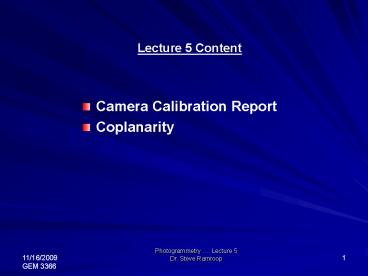Photogrammetry ' Lecture 5 - PowerPoint PPT Presentation
1 / 24
Title:
Photogrammetry ' Lecture 5
Description:
Other information is obtained from the camera calibration report which is used ... Image Coordinates of GCPs and Tie points. Ground Coordinates of GCPs and Tie points ... – PowerPoint PPT presentation
Number of Views:277
Avg rating:3.0/5.0
Title: Photogrammetry ' Lecture 5
1
- Lecture 5 Content
- Camera Calibration Report
- Coplanarity
2
Camera Calibration Report
- On Calibration Report, PP is usually defined as
Principal Point of Autocollimation
- Given as Xo, Yo
- Other information is obtained from the camera
calibration report which is used to compute the
orientation parameters
3
Camera Calibration Report
4
Camera Calibration Report
5
Camera Calibration Report
6
- The relationship between the image and object
coordinate systems is expressed by a 3x3
orthogonal matrix (M) - Rotation around the x axis ? ? (omega)
- Rotation around the y axis ? F (phi)
- Rotation around the z axis ? ? (kappa)
- Azimuth ? a
- Tilt ? t
- Swing ? s
7
C
- a azimuth is the clockwise angle from the
ground Y-axis to the principal plane - t tilt is the angle between the vertical line
through the exposure point and camera axis - s swing is the angle measured in the plane of
the photograph clockwise from the y axis to the
nadir point of the principal line
f
y
t
Z
x
s
n
Y
a
X
8
- For the orientation matrix (m) the nine elements
are functions of ?,F,? or a,t,s - The elements are the nine cosines of the spatial
angles that each of the axes x,y,z makes with the
axes X,Y,Z
9
- Substituting into the colinearity equation
(akMA) for M
- Multiplying through the RHS and equating the
terms on the LHS
- Dividing the first and second equation by the
third
10
Least Squares Adjustment
- Collinearity Equations can be solved using the
Least Squares Adjustment approach - This technique adjusts your measurements and
estimates the unknowns by minimizing and
spreading errors throughout a set of sequential
photos (called a block) - Statistical techniques automatically identify,
distribute, and remove error
11
Least Squares How it works?
We measure
12
Measurement Quality
Can be thought of as the POSSIBLE ERROR in your
measurements Quality estimates are inputted into
the Block Tool
For the ground measurements
13
Measurement Quality
For the ground measurements
We define a standard deviation which indicates
the quality of the measurement
Eg. SD of 5m GCP is within 5m of its true
location (X,Y,Z)
14
Measurement Quality
Perspective Centers also need estimates of
quality (X,Y,Z)
Also entered as standard deviation values
For Image measurements We define a standard
deviation which indicates the quality of the
digitizing
e.g. SD of 1 pixel Point is within 1 pixel of
its true location
15
Quality Estimates What they do
Adjustment process will move your points until
the best solution is found
Inputted Standard Deviations (Measures of Quality)
The points fluctuate only within the limits of
the specified standard deviation values
Adjustment takes place in the X, Y AND Z direction
16
What is the Best Solution ?
- Based on the residuals of the adjustment
This is only ONE residual Least squares approach
tries to minimize measurement residuals across an
entire block...
17
- Coplanarity
- Object points are recorded on two or more
photographs - Since two rays of light originally emanate from
the same object point at the time of photography,
they must therefore be coplanar - Enforces the fact that two camera stations, two
image points, and object point all lie on one and
the same plane
18
Building The Relationship
- A mathematical relationship between Image Space
and Object Space relies on the measurement of
Control Points
Mathematics can build a relationship between
these values these values
19
Epipolar Plane
- Created using the Triangulation Results
- A triangle formed between two perspective centers
and a ground feature - Trying to find X, Y, Z for point on the ground
20
- Coplanarity (Continued)
21
- Using the polygon rule of vector algebra the
following are the vector format of the coplanar
condition - B A1 A2 0
- B ?1 a1 ?2 a2 0
- Where ?1 and ?2 are scalar factors (using the
colinearity condition)
Airbase components
22
- Referring a1 and a2 to the same coordinate system
for the two photos
23
- Substituting into the coplanarity equation
- B ?1 a1 ?2 a2 0
- removes ?1 and ?2 leaving only one equation
which is written as a determinant
- Which is expanded to give
L1L2 ? camera stations a1a2 ? image points
24
- The End































